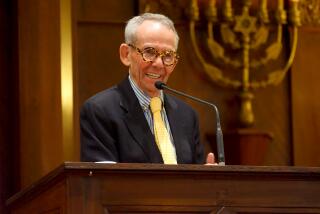A brilliant, original mind
John HAFFENDEN’S superb “William Empson: Among the Mandarins,” the first of a two-volume biography of Britain’s most brilliant and influential literary critic, captures the multiple angles of an unusually complex man. The broadcaster Alistair Cooke, admitting he had never been a close friend of William Empson’s, recalled him as “an icicle that never melted”; contrasted with that is the image of Empson engaged in primal screams on a 1939 visit to Los Angeles and, when offered young girls in Hanoi, roaring for the services of “un sergeant negre enorme de regiment senegale.” You can see that this personality was anything but straightforward.
Empson taught us how to read literary works by freeing them, as Haffenden explains, from any “relation to the author’s life and times.” He shows us just why Empson’s most celebrated work, “Seven Types of Ambiguity” (1930), and its more accessible successor, “Some Versions of Pastoral” (1935), reshaped the nature of literary criticism and resulted in his being honored as the founding father of the New Criticism school that took hold in 1950s America. (One of Haffenden’s main concerns is to dispose of the notion that Empson was a graceless magpie who grew famous on other critics’ ideas.) He also lets us see the glory of Empson’s poetry and why he was so admired by his rivals. Louis MacNeice, Robert Lowell, W.H. Auden, John Betjeman, Dylan Thomas and John Berryman -- all united in their respect for his work. T.S. Eliot, no intellectual slouch himself, once remarked that “Bill has more brain power ... than the rest of ‘em poets.”
Eliot didn’t add -- and Haffenden is careful not to make too much of -- the fact that Empson’s was a brain frequently fuddled with alcohol to the point of near-annihilation (volume 2, perhaps?). Here, while recording Empson’s frequent lapses from sobriety, Haffenden is more concerned with justifying the assertion made by another critic that Empson stands alongside Samuel Johnson and William Hazlitt, not only because of his brilliance as a literary critic, but also because of his wit.
Courage and determination, rather than wit, were the qualities that showed up early on in what promised to be an unremarkable life, albeit one marked by tragedy. Empson’s oldest brother was killed in a military flying accident in 1914, when William was 7; his father, a genial Yorkshire landowner, died two years later. Teased at home for his lack of sporting skills, he was known at school as “Owl” Empson, an allusion to his appearance (he was short, with a round, red and bespectacled face) rather than to his academic prowess.
At 19, he was judged amusing but unremarkable by his school colleagues and tutors; reaching Cambridge that fall, he began to show signs of an inquiring and retentive mind that thrived on debate, analogy and all the literary nurture it could get. This made him admirably suited to the kind of discussions he discovered were the norm in his new environment; after doing some theater and film reviewing, Empson threw himself into publishing poetry with the almost willfully difficult Experiment Group, whose endeavor it was to reflect and refract the mood of the times. Empson produced at this time “Camping Out,” a bizarrely lovely poem that begins: “And now she cleans her teeth into the lake.”
I.A. Richards, a gently loquacious Welshman who became one of Empson’s closest friends and allies, was the star of the literary firmament at that time, the man whose ideas about the moral function of literary criticism would exert a distinctive influence on both Empson and his shrewish contemporary F.R. Leavis. Richards’ biographer, John Paul Russo, has claimed that everything in the extraordinary “Seven Types of Ambiguity,” which Empson started writing in 1928 (he was only 22), derived from his admired mentor; Haffenden slams into this claim like an armored truck running over a rag doll. He points out that Richards and Empson both clearly stated they had spent no more than two hours discussing ambiguous language, about which they disagreed.
Richards’ main contribution to the book was to listen to his pupil, who described a brilliant analysis he’d read of the lexical subtleties of a Shakespearean sonnet, and to suggest that Empson develop his own thoughts into a book. A week later, Empson had written 15,000 words. The analysis in discussion was “A Survey of Modernist Poetry” (1927), jointly written by 32-year-old Robert Graves and his difficult colleague, Laura Riding. Riding was vociferous in her insistence that she should be credited by Empson as a primary source for his own book. But there is no doubt in Haffenden’s mind that Graves had provided the germ in an earlier, independent discussion of “The Duchess of Malfi” and the multiple meanings that could be extracted from Ferdinand’s agonized cry: “Cover her face; mine eyes dazzle.”
“Dazzle,” Riding angrily informed Empson years later, had only one meaning; both he and Graves were idiotic to suppose otherwise. Unwittingly, she gave the game away. With that attitude, she could never have inspired Empson to his demonstrations of the number of meanings that can be decoded from a literary passage.
Empson’s development into one of the most charismatic poets of the 1930s is a subject about which Haffenden writes with immense shrewdness and warmth. He makes sure no reader will ever again believe Leavis’ vicious ranking of Empson below the second-rate and rightly forgotten Ronald Bottrall. Empson was a courageous poet with a ravishing feel for language. (Consider, for example, his description of an English meadow “all roaring with its lush and careless summer.”) Poetry coursed through him like lifeblood; when, in the late 1930s, he was teaching literature in China at a university that had no books, he simply drew on the texts he knew by heart. His students never forgot the experience.
Empson went to China in 1937 and taught there during the Second Sino-Japanese War, after spending three years in Japan. In China, where the tradition of inebriated poets stood him in good stead, no objection was made to his reckless consumption of alcohol. He had probably acted under the influence of drink three years earlier when he tried to seduce a male taxi driver in Tokyo, was reported and lost his teaching post. The act was typical Empson; at Cambridge, he forfeited a fellowship when he was found to have used his rooms for lovemaking, this time with a woman.
The carelessness -- in both cases, the reader senses, he seems almost to have been courting disaster -- played into a notorious aspect of Empson’s life: his personal hygiene. A Granta magazine parody of the young critic, which depicted him as lying in a welter of banana skins while sucking ink from the carpet, understated the spectacular squalor in which Empson lived with magnificent indifference. It’s possible, although Haffenden does not explore this idea, that his asceticism -- no sheets on the bed, a bike as his means of transport -- connects to the fascination with Buddhism that became, for a fierce atheist, religion’s only acceptable face.
A work of scholarship and passion, Haffenden’s “Among the Mandarins” is a fine book that should restore Empson to the pedestal from which he had begun to slide. It will, above all, bring readers back to one of our most invigorating and rewarding poets and critics. *
*
To an Old Lady
*
William Empson
*
Ripeness is all; her in her cooling planet
Revere; do not presume to think her wasted.
Project her no projectile, plan nor man it;
Gods cool in turn, by the sun long outlasted.
Our earth alone given no name of god
Gives, too, no hold for such a leap to aid her;
Landing, you break some palace and seem odd;
Bees sting their need, the keeper’s queen invader.
No, to your telescope; spy out the land;
Watch while her ritual is still to see,
Still stand her temples emptying in the sand
Whose waves o’erthrew their crumbled tracery;
Still stand uncalled-on her soul’s appanage;
Much social detail whose successor fades,
Wit used to run a house and to play Bridge,
And tragic fervour, to dismiss her maids.
Years her precession do not throw from gear.
She reads a compass certain of her pole;
Confident, finds no confines on her sphere,
Whose failing crops are in her sole control.
Stars how much further from me fill my night,
Strange that she too should be inaccessible,
Who shares my sun. He curtains her from sight,
And but in darkness is she visible.
*
From “The Oxford Book of English Verse,”
edited by Christopher Ricks
(Oxford University Press: 690 pp., $39.95)
More to Read
Sign up for our Book Club newsletter
Get the latest news, events and more from the Los Angeles Times Book Club, and help us get L.A. reading and talking.
You may occasionally receive promotional content from the Los Angeles Times.







